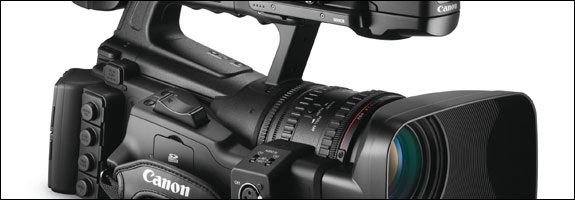LAKE SUCCESS, N.Y., April 7, 2010 – Canon U.S.A., Inc., a leader in digital imaging, today announces the Canon XF305 and XF300 Professional Camcorders. Both new models employ an MPEG-2 4:2:2 50Mbps codec – Canon XF Codec – for capturing and recording native 1920 x 1080 video onto affordable, universally available Compact Flash (CF) cards. Uniting video, audio and metadata into a single file, the Canon XF305 and XF300 use an MXF (Material eXchange Format) File Wrapper, a widely supported open source format, to maximize compatibility with existing industry infrastructure and non-linear editing (NLE)systems. Priced under $8,000 per model, the Canon XF305 and XF300 are engineered for multiple production applications including broadcast news, documentary and independent filmmaking and event videography. Canon will be demonstrating a variety of professional applications for the Canon XF305 and XF300 at the Company's booth# C4325 at the 2010 National Association of Broadcasters (NAB) Show in the Las Vegas Convention Center.
The Canon XF305 and XF300 Professional Camcorders include a Genuine Canon 18x HD L-series lens providing documentary filmmakers and news camera operators with the focal-range versatility required in the field. Designed with input from professional users, each model includes three Canon developed and designed native 1920 x 1080 CMOS image sensors, and the new Canon XF Codec for extreme color detail required for accurate chroma-keying, color-grading and compositing for digital filmmaking. For finer transitions in tone and color, 4:2:2 color sampling offers twice the color resolution of HDV and other 4:2:0 formats. In addition, Canon's XF305 model features industry- standard HD-SDI output, genlock, and SMPTE time code (in/out) terminals for multi-camera or 3-D productions.
Yeah, this is oldish news, I was super busy today. :)
cr


26 Comments
Only because you are comparing 7 year old CCD design to a current CMOS.
Canon and Sony switched to CMOS in their consumer products to make more profit, not increase image quality.
Independently settable sensitivity for the color channels.
You don’t clip one channel while having noise creep into an other due to to much amplification just because of white balance.
What current camera has full-raster 1920×1080 1/3″ CCD’s? Sorry, none of them. If you want to get full-raster resolution out of a 1/3″ chipset, C-MOS is the only way to do that right now.
“Canon and Sony switched to CMOS in their consumer products to make more profit, not increase image quality.” Wow – hyperbole much? Then why are so many people clamoring for C-MOS picture quality? Sony & Canon increase profit by increasing image quality in their cameras while keeping the price affordable, and thus selling more cameras. So in a way, I guess you’re right and wrong.
Seems like a lot, if there were 3 1/2 inch sensors like those you find in the SONY EX-1 or EX-3 then it would be cool at that price, but that’s not the case. I’d still go EX-3/EX-1.
Here is what I found
Sony Coming with interchangable lens camcorders that takes sony’s dslr lenses